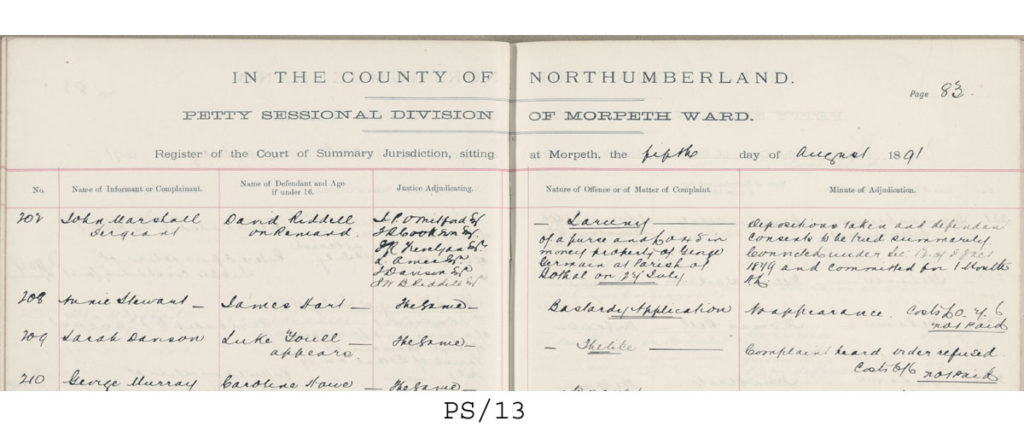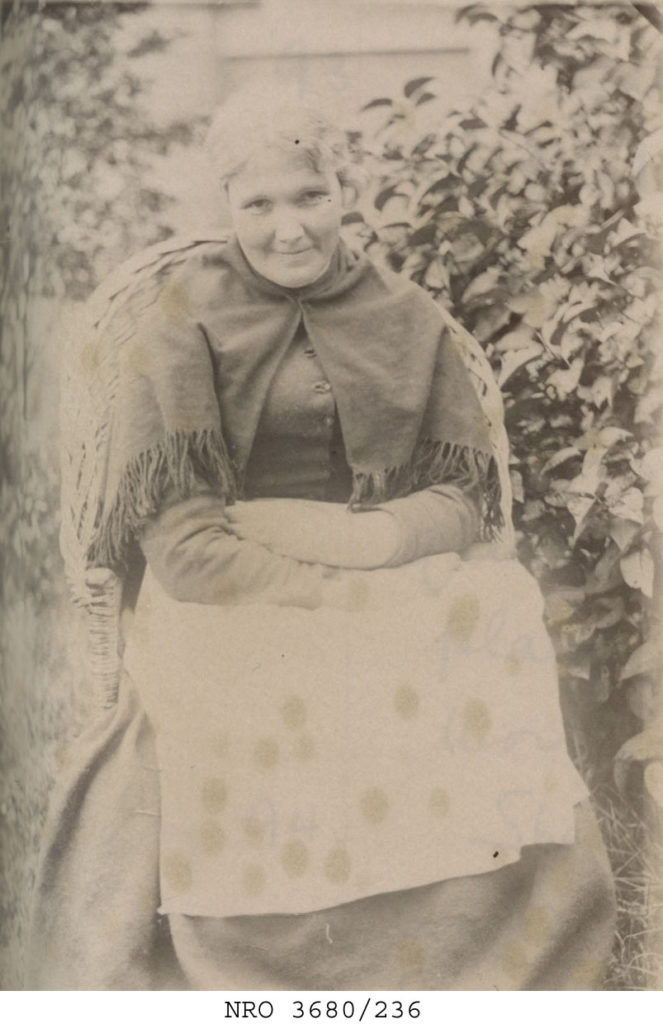In July 2016 we ran a blog about St. George’s Hospital, Morpeth, the former County Lunatic Asylum, describing life in the Asylum. In this blog we will look at a particular class of record found amongst the records of the Asylum and held by Northumberland Archives – the patients’ case books – and use an example of one case to show how the records can be used to build up a biography of a patient. In the early period of the hospital from its establishment in 1859 information concerning patients can be found in the admission registers. These provide brief details about the patient and their condition – name, address, age, gender, marital status, occupation, union or parish responsible for financing patient’s stay in hospital, diagnosis, supposed cause, comments about physical health further information about the illness and the outcome – whether the patient died, was discharged or removed.
In 1890 a new series of records was introduced – patient’s case books. These records provide much more detailed information about the patient as we will see when considering the case of Sarah Davison (patient number 1645). Introductory information in the case book reveals that Sarah Davison was admitted to hospital on 9 August 1891. She is described as a 38 year old widow, a field worker living at Mitford Steads Farm, an Anglican and that the supposed cause of illness is ‘failure to affiliate child’. Affiliation or filiation refers to making a maintenance claim for financial support of an illegitimate child through the court system. This reference is supported by an entry in the Morpeth Petty Sessions Register of Summary Jurisdiction of 5 August 1891 – Sarah Davison brought a bastardy application case against Luke Youll that was not upheld. A search of the 1891 census reveals only one person named Luke Youll – a 24 year old farm servant living at Sturton Grange, near Warkworth, Northumberland. Details in the case book suggest some unpleasantness surrounding the filiation case – Sarah was the recipient of ‘taunts and insults from the relatives of the reputed father’ and the failure to secure the affiliation order are attributed as the cause of Sarah’s illness. It does appear that there is at least the possibility that Luke Youll was the father of the child – he had been providing maintenance payments from the birth of the child eleven months ago.

The case was not the only distressing circumstances of Sarah’s life. We learn from the case notes that ‘she had a good deal of trouble about 8 years ago her husband and 3 children dying within 13 months …’. The casebook also reveals that Sarah’s father, Joseph Thornton, suffered from mental illness. . We learn that ‘he is said to have been 3 times in this Asylum being 16 years ago. The cause assigned in this case being the loss of a suit at law’. Further evidence of family history of mental illness is provided – the case book notes that ‘the father’s brother is also described as not quite compos mentis’. This information can be used to undertake further research into the family and we will explore this in a future blog.
The case books provide a physical description of the patient. Sarah is described as ‘A slightly built woman somewhat above the average height. Weight about 110lbs. Hair brown turning grey … teeth remarkably bad. Expression not very intelligent’. Accompanying the physical description there is a photograph of the patient. Many of the patients appear to be wearing similar clothing suggesting that there may have been a hospital uniform.

A description of Sarah‘s mental condition is also provided – ‘She is noisy restless & incapable of rational conversation. Does not know where she is or when she came here. With a little management she lies quietly in bed during examination, but is reported noisy, restless, knocking on shutter or spitting during the morning’. Later on she is diagnosed as suffering from ‘acute mania’, in other words suffering from manic episodes. On 13 August 1891 it was recorded as ‘noisy, restless, incoherent, laughs & cries without apparent reason … resists all attempt at examination, occasionally refuses forcible feeding…’. By 25 August Sarah appeared to have recovered from this episode – ‘She is now up taking food herself and sewing & is in every way greatly improved’. However, on 14 September 1891 it is recorded that Sarah had suffered relapse – ‘… was very excitable & violent last night till midnight & has been noisy since’. This episodic behaviour continued through Sarah’s confinement to hospital. The case book entry of 3 April 1897 records ‘No change. She is now quite demented and occasionally abusive’. The apparent change in diagnosis is interesting – dementia was another commonly used diagnosis and in some instances may have been used to describe what we know as schizophrenia. Able patients were expected to be involved in some work activity – hence the reference to sewing. Later on, we learn that Sarah is employed in the laundry. By 1895 Sarah has been diagnosed as a chronic patient – one with little chance of full recovery – and had been placed in a refractory ward – solitary confinement. Sarah Davison died at St. George’s Hospital on 24 August 1903. Cause of death was influenza and cardiac failure. She had remained a patient at the hospital since her admission twelve years previously.

Northumberland Archives holds patients’ case books for St. George’s Hospital from 1890 until the mid-20th century. These volumes contain information about hundreds of patients that were treated at the Hospital throughout this period and many of the volumes includes photographs of the patients- for some researchers this may be the only photograph of a family member that survives. Due to the sensitive nature of the content the volumes are ‘closed’ for 100 years – meaning that there is no public access to records that are less than 100 years old. However, it is sometimes possible to gain access to a ‘closed’ record if you are a descendant of a patient. Staff can provide further details about the process to gain access.

The information I have read was very interesting.
But was very sad to read about Sarah Davidson I suppose in them days you would be put in those places for anything.
My Great Grandmother and my Great Great Grandmother were put in a sanatorium all because they suffered Under Active Thyroid Glands, but then no one new what the problem was until the early thirty’s.
My mother use to tell me how they just sat there staring into space.
Because it is hereditary my mother suffered from it I have it and my uncle also has it on my fathers side. Funny thing is all off them were the youngest in our familys including myself.
Interesting reading.I think the same about being put there for anything.
My mother only mentioned her father once and became upset.
It sounds like he had a nervous breakdown but can’t be sure.
I’ve 4 years to wait for access to records.
I wish I could view now before it’s too late.
Interesting information.My Maternal grandfather died in St George’s in 1924 so I have 4 years to wait for access to the records.
My cousin in his 80s would like to see the records.I only found out from my mother just before she died about her father.
She was upset so I never asked further questions.
She said he was a gentle man and sounds like he had a nervous breakdown but unsure.He was a Pitman so no wonder working in a black hole.I would dearly love to read the actual records before it’s too late.Thankyou for this site.
Thank you for your comment.
This is very interesting. Prior to the case books being introduced in 1890, was the only information held regarding a patient, to be found in the admissions register? Regardless of how long they were a patient? Thank you
Thank you for your enquiry. Unfortunately, prior to 1890 the only information we hold about patients is in the admission registers regardless of how long they were a patient in the asylum.
At last I received the details of my grandfather’s stay in St George’s.It was upsetting to read but I’m so pleased to learn more about the reason he was admitted.We didn’t ask back then which is sad.
What a fabulous place Woodhorn is.
I’m now wondering if when patients died there was a cemetery at St Georges or were they taken to their local Churchyard.
Thankyou.